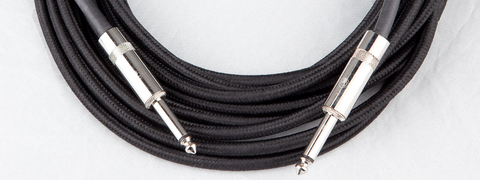-
Audio
-
Guitar
-
Bass
-
Blog
-
SALE
- Financing
- Support
- SINCE 1946
October 07, 2016

Somewhere along the line somebody probably told you “Don’t ever use guitar cables for speakers and vice versa!” If not you will be glad you noticed this article because it might save you some trouble down the road. What seems confusing is that from outward appearances the two cables can look much the same, if not identical. The plugs are interchangeable in most cases as well. So let’s take a look at why they are different, what they are optimized for, and why they don’t make good substitutions for one another.
Instrument (guitar) cables are designed to transfer the very small signal your guitar pickups generate or the line level signals from a preamp or mixer to an amplifier input. They need to do this without collecting a lot of outside interference. This is important because any small electrical signals it picks up on the way to your amp input will be amplified right along with your instrument! To prevent this, guitar cables have a small central conductor to carry the low level signal to the amp and a large outer shield of twisted or braided copper to ground out interference before it gets into your signal chain.
Speaker cables must carry a much more powerful signal as they come after your amplifier has boosted the signal level many times over (how loud is your amplifier compared to what your electric guitar sounds like unplugged?) Those high AC currents allow your power amp to move large, heavy speakers and a lot of air to create sound. So speaker cables must have very large conductors compared to instrument cables. On the other hand because the signal level they carry is so high, outside interference isn’t a problem (without being amplified it can’t compete with your amp’s output), so speaker cables do not have an outer ground shield like your instrument cables.October 02, 2025
Discover the features and performance that the WG6 Wireless Guitar/Bass System has to offer. The WG6 Wireless Guitar/Bass System is designed to give you the wireless freedom you have been looking for and the simplicity to make your life as a working musician easier. Advanced wireless technology, multiple channel capability, premium audio processors make the WG6 the leader in compact wireless instrument systems. Defined and detailed low frequency response makes this system especially useful for bass players. The WG6 works with both active and passive instruments and is perfect for both electric and acoustic guitar/bass.
March 28, 2025
At any time at any gig, something is bound to go wrong and you may need a tool to get you back up and running. Here are a few basic tools you should bring to every gig.
January 09, 2025
I once asked blues legend Walter Trout why he still plays his well-worn vintage Strat. The technology exists to digitally scan the guitar and make very accurate replicas. His response was he could leave it at home, but then it will never be played. Plus, someone could steal it from his home. At least the guitar is with him and he has the pleasure of playing it. But this may not be the same for everyone.
Sign up to get the latest on sales, new releases and more…
NoFraud Frequently Asked Questions
"Make a joyful noise unto the Lord all of the earth; make a loud noise and rejoice and sing praises. Sing to the Lord with the harp and the voice of the psalm." - Psalm 98:4-5
© 2025 Carvin Audio.
Carvin Corp.
POS and Ecommerce by Shopify
